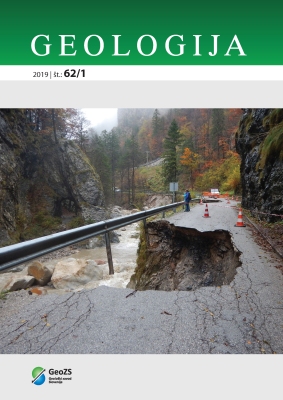Review of geological and seismotectonic investigations related to 1998 Mw5.6 and 2004 Mw5.2 earthquakes in Krn Mountains
DOI:
https://doi.org/10.5474/geologija.2019.002Abstract
A review of geological and seismotectonic investigations conducted in the two decades after the 12 April 1998 earthquake in Krn Mountains, according to its magnitude the strongest earthquake in Slovenia in the 20th century, is given. Many of these studies have wider scientific meaning than expected from the size of the earthquake. This was the first case in Slovenia that a strong earthquake was undoubtedly related to a particular fault. Seismotectonic studies of seismogenic Ravne fault revealed that it is an actively propagating strike-slip fault growing by interaction of individual right stepping fault segments and breaching of local transtensional step-over zones. Airborne laser scanning (LiDAR) of Idrija and Ravne faults, which resulted in high resolution bare earth digital elevation model, was in 2005 for the first time used to study surface expression of an active fault in Europe. Among the primary characteristics of the 1998 earthquake were extensive environmental effects expressed mainly as massive rockfalls. They were systematically documented and evaluated for intensity assessment using European Macroseismic Scale (EMS-98) and Environmental Seismic Intensity (ESI) scale introduced in 2007, because application of the data on damage to buildings was limited in sparsely populated high mountains epicentral area. These studies were pioneering due to novelty of both intensity scales, indicating their strong points and weaknesses. Large variations in damage to buildings in the upper Soča valley at similar epicentral distances pointed to strong site effects due to very heterogeneous glacial and fluvial deposits in sedimentary basins and valleys. Therefore, different seismic microzonation maps were prepared to evaluate the influence of soft sediments on seismic ground motion. Conducted studies fostered development of several earthquake geology research methods in Slovenia as tectonic geomorphology, evaluation of environmental seismic effects and seismotectonics. They had positive impact also on the university education in the fields of geophysics, seismology and structural geology.Downloads
How to Cite
Gosar, A. (2019). Review of geological and seismotectonic investigations related to 1998 Mw5.6 and 2004 Mw5.2 earthquakes in Krn Mountains. Geologija, 62(1), 61–73. https://doi.org/10.5474/geologija.2019.002
Issue
Section
Articles

